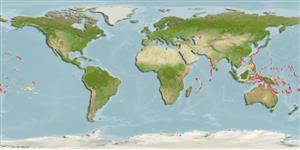>
Kurtiformes (Nurseryfishes, cardinalfishes.) >
Apogonidae (Cardinalfishes) > Apogoninae
Etymology: Apogon: Greek, a = without + Greek pogon = chin, beard (Ref. 45335); caudicinctus: From the Latin word 'cauda' for tail and 'cinctum' for girdle or belt, in reference to the broad blackish bar across the posterior caudal peduncle and base of caudal fin..
More on authors: Randall & Smith.
Environment: milieu / climate zone / depth range / distribution range
Ecología
marino asociado a arrecife; rango de profundidad 0 - 40 m (Ref. 126002). Tropical; 30°N - 22°S, 54°E - 130°W
Distribución
Países | Áreas FAO | Ecosistemas | Ocurrencias, apariciones | Point map | Introducciones | Faunafri
Indo-Pacific: Réunion Island, and Mauritius (Ref. 33390) east to the Pitcairn Group, including Rapa Island in the south-central Pacific, north to Bonin/ Ogasawara Islands (Ref. 33390) and Ryukyu Islands.
Tamaño / Peso / Age
Maturity: Lm ? range ? - ? cm
Max length : 12.0 cm SL macho / no sexado; (Ref. 126002)
Espinas dorsales (total): 7; Radios blandos dorsales (total): 9; Espinas anales 2; Radios blandos anales: 8; Vértebra: 24. Distinguished by having the following characteristics: dorsal-fin rays VI-I, 9; anal-fin rays II, 8; pectoral-fin rays 12; pelvic-fin rays I, 5; pored lateral line scales 24; predorsal scales 7; circumpeduncular scales 12; total gill rakers 16, developed gill rakers 10; second spine length of first dorsal fin 1.8 in head length (Ref. 93839). Body color transparent red, edges of dorsal body scales dark, diffused blackish bar across posterior half of caudal peduncle; depth 2.95-3.45 in SL. Long and slender caudal peduncle 3.30-3.35 in SL.
Found in reefs or rocky substrate with caves and ledges at depths of less than 12 m (Ref. 10632); to 40 m (Ref, 126002).
Life cycle and mating behavior
Madurez | Reproducción | Puesta | Huevos | Fecundidad | Larva
Mouthbrooders (Ref. 240). Distinct pairing during courtship and spawning (Ref. 205).
Randall, J.E. and C.L. Smith, 1988. Two new species and a new genus of cardinalfishes (Perciformes: Apogonidae) from Rapa, South Pacific Ocean. Am. Mus. Novit. (2926):1-9. (Ref. 10632)
IUCN Red List Status (Ref. 130435)
Threat to humans
Harmless
Human uses
Más información
ReferenciasAcuiculturaPerfil de acuiculturaRazasGenéticaElectrophoresesheritabilidadEnfermedadesProcesamientoNutrientsMass conversion
ColaboradoresImágenesStamps, Coins Misc.SonidosCiguateraVelocidadTipo de nataciónSuperficie branquialOtolitosCerebrosVisión
Herramientas
Special reports
Download XML
Fuentes de Internet
Estimates based on models
Preferred temperature (Ref.
123201): 25.3 - 29.3, mean 28.5 °C (based on 1624 cells).
Phylogenetic diversity index (Ref.
82804): PD
50 = 0.5000 [Uniqueness, from 0.5 = low to 2.0 = high].
Bayesian length-weight: a=0.01072 (0.00473 - 0.02425), b=3.09 (2.92 - 3.26), in cm total length, based on LWR estimates for this Genus-body shape (Ref.
93245).
Nivel trófico (Ref.
69278): 3.6 ±0.5 se; based on size and trophs of closest relatives
Resiliencia (Ref.
120179): Alto, población duplicada en un tiempo mínimo inferior a 15 meses (Preliminary K or Fecundity.).
Fishing Vulnerability (Ref.
59153): Low vulnerability (10 of 100).
Nutrients (Ref.
124155): Calcium = 209 [120, 445] mg/100g; Iron = 1.28 [0.69, 2.17] mg/100g; Protein = 19 [18, 20] %; Omega3 = 0.161 [0.085, 0.313] g/100g; Selenium = 25.7 [11.7, 53.9] μg/100g; VitaminA = 96.9 [30.2, 309.0] μg/100g; Zinc = 2.6 [1.6, 3.9] mg/100g (wet weight);
